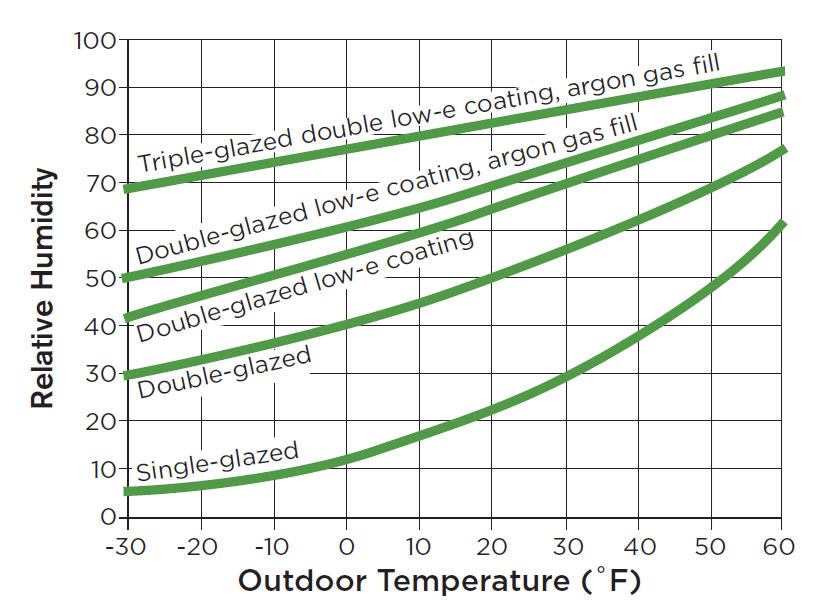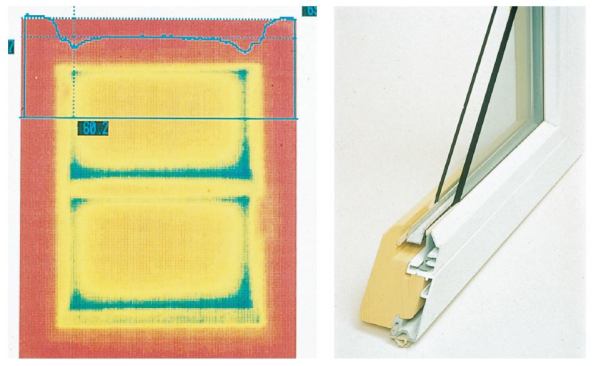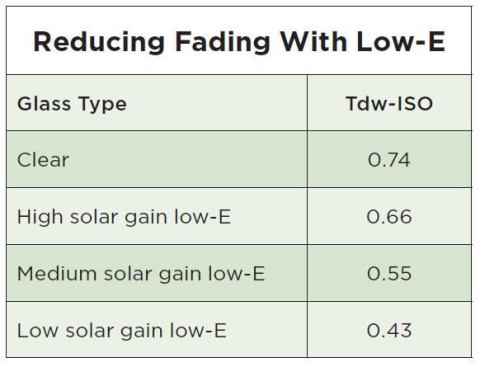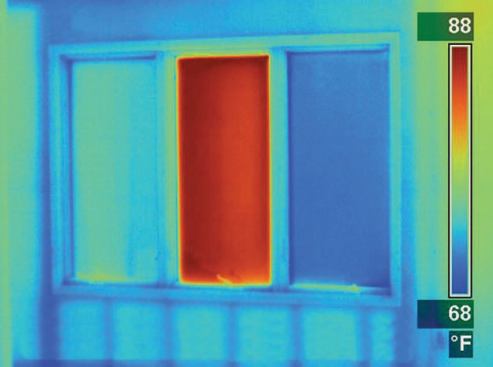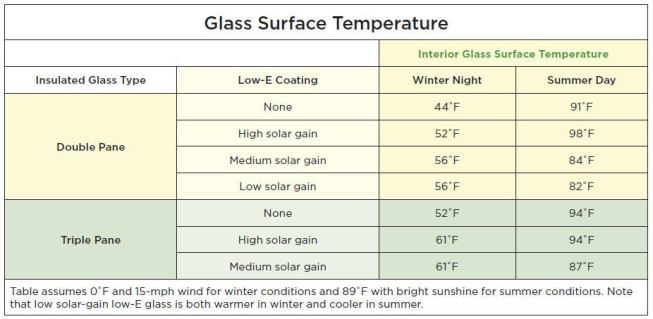Conductive heat loss around the perimeter of insulated glass uni…
Reducing Fading With Low-E
The spectral selectivity of low-E coatings allows them to block significant amounts of UV light. Research into the fading of fabrics, artwork, finishes, and home furnishings has shown that the radiant energy that affects fading includes portions of the visible light spectrum in addition to UV. The International Organization for Standardization (ISO) has proposed a damage-weighted scale called Tdw-ISO that accounts for the effects of both UV and visible light. The ratings for low-E glass suggest that low-solar-gain low-E glass with a rating of 0.43 would reduce the rate of fading by over 40 percent compared with clear glass rated at 0.74.
It’s not appropriate to claim that a glass type can “eliminate” fading altogether. If light passes through, there will always be a risk of fading. Also, the rate of fading will vary with the type of material and the exposure levels. Keeping a sensitive material out of direct sunlight is always a good idea.
Comfort Is the Issue
A study commissioned by Pacific Gas and Electric several years ago discovered that the No. 1 reason customers make energy-efficiency improvements to their homes is to increase comfort. Windows have a huge impact on comfort. When it’s 40°F outside, the inside surface temperature of a single-pane window can be 20°F colder than room temperature. Since our bodies radiate heat to colder surfaces, a room full of poorly insulating windows can make us feel uncomfortable (by radiant cooling) even if the home is well-insulated. High-performance technologies can make windows feel warmer during cold weather by keeping the temperature of the interior glass surface higher.
While winter performance is important, the right window can also have a big impact on comfort in the summer – and on air-conditioning costs. Since more than 40 percent of existing homes and 80 percent to 90 percent of new homes have air conditioning, it makes sense to pay close attention to a window’s solar heat-gain properties as well.
In warm weather, clear glass and high-solar-gain low-E will increase cooling loads and air-conditioner size. In cold climates, solar gain can be used to offset heat losses, but this requires a system design approach. Windows should face south for best winter sun exposure, and overhangs should be designed to shade the glass in the spring and fall. If large amounts of south-facing glass are used, the building should be designed by an experienced solar designer, and it may need thermal mass to absorb solar gains, and a circulation system to distribute the stored gains. Even with all of that, many passive-solar buildings experience daily temperature swings that don’t meet the comfort expectations of many homeowners.
Striking the right balance. Choosing the optimal glazing type for both winter and summer performance can be tricky. However, computer modeling indicates that the sweet spot for most homes in the U.S. is argon-filled double glazing with medium-solar-gain low-E (SHGC from 0.25 to 0.35, U-factor of 0.28 to 0.32). This will provide warm inside glass temperatures on cold winter nights and limit unwanted heat gain in summer. In hot southern climates, it makes sense to use the lowest SHGC available.
Reasonable Cost
As with the Energy Star program, national building codes have adopted window- efficiency requirements that basically mandate low-E everywhere in the country. Given that the cost of upgrading from clear double glass to a gas-filled low-E window is less than $1 per square foot of glass area, most studies show that the payback period for choosing low-E will be less than one year – and this does not even take into account the cost savings of a downsized furnace and air-conditioner.
Triple glazing may be cost-effective in extremely cold climates, but with a longer payback period, this option would need to be evaluated on a case-by-case basis.
In retrofits, while it may not be cost-effective to replace old windows based on energy savings alone (depending on the new window and installation costs), once you have decided to replace the windows, upgrading from clear glass to low-E will provide a payback as quickly as in new construction.
Dealing with Condensation
Condensation on windows – which can lead to disappointed customers and callbacks – can be reduced with new glazing technologies. Use the chart below to predict whether condensation will form on a given window under certain conditions. Low-E windows can prevent the formation of condensation until relative humidity levels reach 65 percent at an outdoor temperature of 20°F. Relative humidity levels above 65 percent are excessive and will likely cause other problems besides dripping windows. It’s a good idea for contractors to carry a digital hygrometer to measure and record indoor relative humidity while they are in customers’ homes.
For More Information
Efficient Windows Collaborative
efficientwindows.org
Building America (U.S. Department of Energy)
buildingamerica.gov
Energy Star Windows Program
energystar.gov/windows
National Fenestration Rating Council (NFRC)
nfrc.org
Lawrence Berkeley Laboratory Building Technologies Program
windows.lbl.gov
Energy Efficient Building Association (EEBA)
eeba.org
American Architectural Manufacturers Association (AAMA)
aamanet.org
